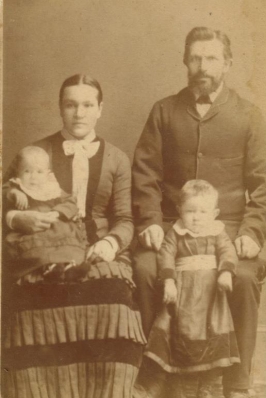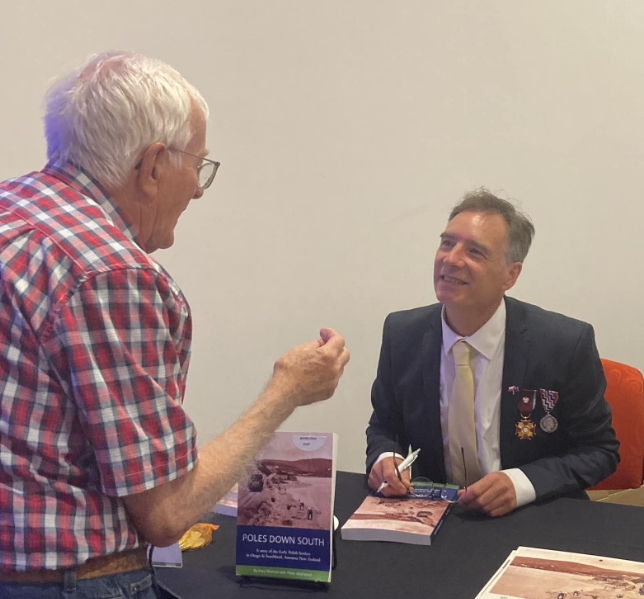Poles Down South

Curiosity drives any family genealogist, and Paul Klemick is a curious man. He was also a curious child.
“I was very young, not even a teenager, when I asked my father where our name came from. ‘What do you want to know that for?’ he said, ‘That lot were all brought and sold as slaves.’
“He always called them ‘that lot.’ When I joined the Polish society some years later, he was still the same: ‘What did that lot ever do for society?’”
Rather than put off his second son, his father’s dismissal of his Polish roots further ignited Paul’s imagination.
“Who were these people? Why were my family like they were? Why did my father call my great-grandfather Phil the Flogger?”

Paul found out that his great-great-grandfather, Franz, arrived in Lyttelton harbour in October 1874, among the Poles aboard the Gutenberg. He was 18, and had travelled with his parents, Maciej Klimek and Anna née Smolińska, and his younger brothers Theodore (Felix) and Martin.
Paul’s great-great-grandmother, 17-year-old Franciszka Chełkowska, arrived in Port Chalmers nearly three months earlier. She was 17, and had travelled on the Reichstag with her married sister Veronica Anis and the Anis family. They settled in Waihola, as did Franciszka after she married Franz Klimek in 1882. Paul’s great-grandfather changed the family name to Klemick when he married Ellen Walsh in 1908.

Dunedin born and raised Paul started gathering and recording information. By the early 1990s, he was corresponding with Taranaki-based Ray Watembach of the Polish Genealogical Society, who had worked with academic Jerzy (George) Pobóg-Jaworowski on his book History of Polish Settlers in New Zealand.
In 1998, Paul answered an advertisement in Dunedin’s weekly publication, The Star, that invited people in the area to join the Polish Heritage of Otago and Southland. He went to the new society’s inaugural meeting, and met Patricia Clark, who had answered the same advertisement. Patricia recognised Paul—for years at Mass at St Paul’s in Corstorphine, she had sat in the pew behind the Klemick’s, and had seen Paul grow up. They found out that they were third cousins, once removed. They met other Poles.
POHOS planned its first exhibition of Poles in Otago, and gave Paul and Patricia the task of gathering material.
“There was no material then. Patricia and I visited and filmed people, and created an exhibition of what we found. By then, I had got to know other Polish people in Dunedin, and found people missing from George’s book.
“Before POHOS, I always thought it would be good to do something for the Polish people. They were a forgotten people, ignored, treated as if they were nobodies. I wanted to promote them in the community. Now they are culturally a part of the community, always counted in when there are cultural events.”
Paul’s grandfather believed the family was German, but Paul knew instinctively that they were not.
“I had a recurring dream as a little boy: I was in Europe, hiding from soldiers in barns, forests, all sorts of places, and always—just before someone saw me—I’d wake. I still remember those dreams.”
In 1994, Ray wrote to Paul: “Your letter is not straightforward, but full of enquiries…” and explained how the Germans, during their partitioning of north-western Poland between 1779 and 1918, germanised Polish names. Ray sent Paul books, church records, and Paul began to build a picture of not only his extended family, but also the families of other descendants of early Polish settlers in the Otago region.

“I spent so much time at the New Zealand Archives in Dunedin, I hadn’t been back for years, but when I popped in the other day, the lady there recognised me.”
Ray at first thought Paul’s family was Kaszubian, but that, too, did not sit well with him.
“At the first POHOS dinner in 1998 with the board members and descendants, I turned the menu over. On the back, were the cultural regions of Poland, and as soon as I saw Kociewie, I knew that was where we came from.”
Paul found his roots, and went three times to Poland to investigate them further.
Since the launch of his book, Poles Down South, in Dunedin this month, other descendants have asked why it took him so long to put together.
“I say to them, yes, it has taken all those years to put together, but it was tough to get my head around all the complex stories. We are all related in some way.”
I counted at least 116 Polish names in just one of the book’s appendices. As a fellow researcher, I appreciate the twists and turns that Paul would have faced in unravelling the information behind all those names, and the unexpected paths that he had to resolve as he followed threads and made sense of the stories attached to those names. This is an informative tome, filled with narrative, and backed by scores of pages of information that invites any family genealogist to pick up and follow.
From me, Paul, well done! I am proud of you and your tenacity. I continue to respect your staunch work-ethic, your dogged research, your patient kindness, and most of all, your unstinting curiosity.
—Barbara Scrivens
30 November 2023
_______________
Anna Gruczyńska took the photographs at the book launch. The family photograph is from the Klimeck family collection. The book’s cover illustration comes from the Toitū Otago Settler’s Museum collection and is named Waihola railway workers.
_______________
To purchase a copy of Poles Down South by Paul Klemick, please contact POHOS through https://polesdownsouth.org.nz/book-launch-poles-down-south/
If you would like to comment on this post, or any other story, please email editor@polishhistorynewzealand.org/
